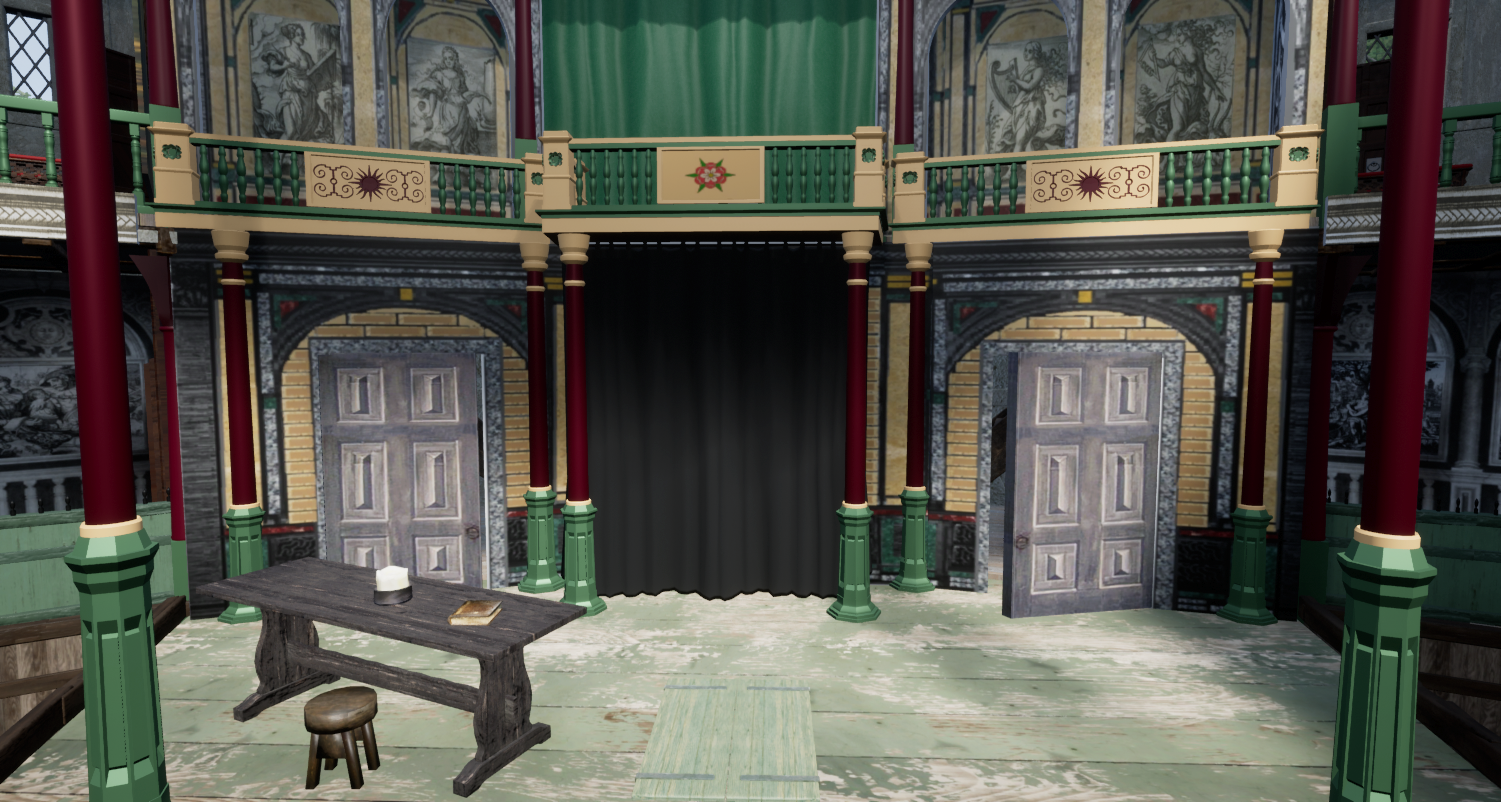Plays thought to have been written for or been staged at the post-1591/2 Rose playhouse require two stage doors:
In Anthony Munday and Henry Chettle’s The Downfall of Robert Earl of Huntington (1601 [c.1598]), a direction reads: ‘Enter Robin Hoode … at one doore, Little John … at another doore’; and later, ‘Enter Scathblocke and Scarlet … at severall doors. To them enter Robin Hoode.’ 333
In Anthony Munday and Henry Chettle’s The Death of Robert Earl of Huntington (1601 [c1598]), a direction reads: ‘Drum. Enter Chester, Mowbray, Souldiers: Lester, Richmond at an other: souldiers.’334
In Thomas Dekker’s Pleasant Comedie of Old Fortunatus (1600 [1595]), a direction gives: ‘Enter Athelstane … at one dore; Fortune, Vice … at another dore.’335
In Look About You, a direction gives: ‘Enter Lancaster & Huntsman at one doore, Lyster & Huntsmen at another’; and ‘Sound trumpets, enter with a Herald on the one side, Henry the second Crowned … on the other part, K. Henry the Sonne crowned.’ 336
In Titus Andronicus, a direction gives: ‘Enter the Emperour…at one doore. Enter at the other doore, Bascianus…’; and later, ‘Enter Aron … at one door, and at the other door young Lucius.’337
In The Brazen Age, a direction gives: ‘Enter at one doore the river Achelous … At the other Hercules.’338
In the model of Phase II, the left and right stage doors have been decorated in the same fashion as in Phase I.
[333] Anthony Munday and Henry Chettle, The Downfall of Robert Earl of Huntington: Afterward called Robin Hoode of Merrie Sherwodde(London: William Leake, 1601), Sig. D1v; E4r (STC 2nd 18271). Henslowe records a payment on 15 February 1598 to ‘Antony Monday’ for ‘a playe booke called the firste parte of Robyne Hoode’; the two parts—The Downfall and The Death of Robert Earl of Huntington, a title which in folklore was associated with Robin Hood—were licensed for performance on 28 March 1598 (Foakes, Henslowe’s Diary, 86); in Henslowe’s inventory of props and costumes taken on 10 and 13 March 1598 (reproduced by Foakes, 317–18, 322), he includes ‘six ‘grene cottes [coats] for Roben Hoode,’ a ‘hatte for Robin Hoode’ and ‘Roben Hoodes sewtte [suit].’ Gurr is certain that The Downfall was written especially for the post-1592 Rose (Gurr, ‘The Rose repertory,’ 123).
[334] Anthony Munday and Henry Chettle, The Death of Robert Earl of Huntington: Otherwise called Robin Hood of Merrie Sherwodde (London: William Leake, 1601), Sig. L1v (STC 2nd 18269). Henslowe’s ‘Diary’ records payments to Munday on 20 and 28 February 1598 for ‘the second pte of Roben Hoode’ (Foakes, Henslowe’s Diary, 87). Gurr is certain that The Death was written especially for the post-1592 Rose (Gurr, ‘The Rose repertory,’ 123).
[335] Thomas Dekker, The Pleasant Comedie of Old Fortunatus (London: S. S. for William Aspley, 1600), Sig. K4v (STC 2nd 6517). Henslowe records multiple entries concerning receipts for performances of ‘Fortunatus’ plays at the Rose, the first dated 3 February 1595 and recorded as ‘the j p of fortewnatus’ [the first part of Fortunatus’] and on 10 and 20 February / 11 and 24 May, ‘fortunatus’; first published in 1600 (Foakes, Henslowe’s Diary, 34–37); in November 1599 Henslowe makes payments to Thomas Dekker for a play called ‘the hole hystory of Fortunatus,’ see Henslowe’s Diary pp. 126–28. Gurr is certain that Old Fortunatus was written especially for the post-1592 Rose (Gurr, ‘The Rose repertory,’ 123).
[336] Anon., Look About You, Sig. A3r, D2r, and I4v.
[337] Shakespeare, The Most Lamentable Romaine Tragedie of Titus Andronicus, Sig. C1v and G1v.
[338] Thomas Heywood, The Brazen Age (London: Nicholas Oakes, 1613), Sig. B2r (STC 2nd 13310).
